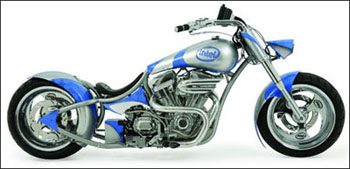Intel is marking its 30th anniversary in the embedded systems market with some new chips and a stylish new motorcycle from Orange County Choppers that employs embedded technologies.
The quarreling Teutul family, which achieved national fame for its motorcycle designs and profane verbal brawls on the Discovery Channel series American Chopper, presented the bike to Intel today at the Embedded Systems Conference in San Jose.
The chopper employs fingerprint recognition as the ignition mechanism, so only the authorized owner can fire it up. The bike also boasts GPS navigation, and uses cameras instead of rear-view mirrors to display the full rear view on the computer screen. The gauges and kickstand are digitally controlled.
Doug Davis, vice president and general manager of the embedded and communications group at Intel (Quote), said Orange County Choppers had to do a lot of collaboration with Black Diamond Advanced Technology, a developer of ultra-mobile computing systems, to protect the systems from the exposure of being on a motorcycle.
The episode showing the construction of the Intel bike will air July 12 and 19 on TLC, the new network for American Chopper.
 |
| Intel’s chip chopper. Source: Intel |
Concurrent with the custom bike, Intel today rolled out its quad-core Xeon 5300 series for embedded systems with extended life cycle support, plus the Intel IP Network Server NSC2U. The Xeon 2.0 GHz E5335 and Xeon 2.33 GHz E5345 are meant for everything from high-end communications and enterprise systems to rack mounts and blade systems.
A Xeon may seem unlikely for an embedded system, which generally comprises a small form factor design with low power draw. Davis said there’s more to embedded than that.
“There’s certainly a subset of apps that are high performance and can take advantage of this kind of processing capability,” he told internetnews.com.
For example, Davis said medical imaging systems may use embedded systems to process up to 16 gigabytes of data in a CAT scan, while many gigabytes of geological data have to be processed for surveying oil and gas.
The Network Server is powered by two 5300 series processors and enables high I/O throughput and performance capabilities for network-centric applications, from security intrusion prevention to telecommunications services-over-IP (SoIP), including IMS, IPTV and Video on Demand (VoD).
This article was first published on InternetNews.com. To read the full article, click here.


